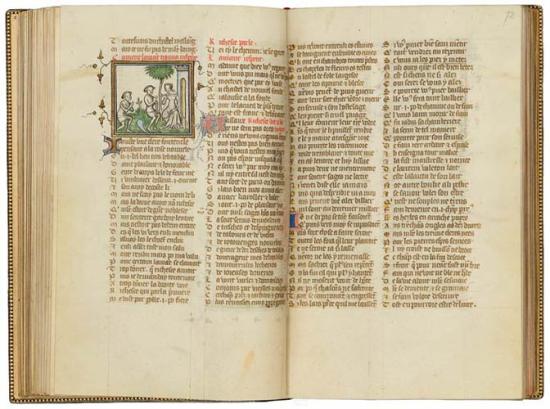
Romance of the Rose, in French
Illuminated by the Master of the Bible of Jean de Sy
Purchased by Pierpont Morgan, 1902
The Lover, the protagonist of the Roman de la rose, is shown twice in this miniature. He is depicted first approaching, then addressing the female personification of Wealth. He wears the hourglass-shaped doublet, with a low, narrow belt, and chaussembles (hose equipped with leather soles). His loose hair, parted in the middle, is that of a youth. Lady Wealth wears a cote hardy with tippets: slender strips of cloth attached to her upper arms (instead of the elbows, as was more customary). Her shoulders are draped with a chaperon, with its hood thrown back, and braids frame her face.
Wasp Waists and Stuffed Shirts
The second half of the fourteenth century was a bleak period in French history. The Black Plague, which first struck in 1348, was a recurring horror. As the Hundred Years' War dragged on, France suffered devastating defeats by the English. Following the Battle of Poitiers in 1356, King John II was captured and taken to London as a prisoner. Fashions changed little during this period.
Men's fashion was dominated by the pourpoint: a close-fitting doublet influenced by the military. With a short flaring skirt and a cinched waist, the pourpoint was padded at the chest and shoulders, giving its wearer a distinctive hourglass silhouette. Pouleines, long pointed shoes, and belts—slender, or the thick "Bohemian" girdle—worn low on the hips complimented the look.
The cote hardy—an outer garment for women—while retaining its voluminous skirt, got even tighter at the bodice, bosom, and sleeves. The resulting look paralleled that of men's fashion. Tippets, decorative strips of cloth hanging from the arms, remained popular. Both men and women continued to wear the chaperon (the hood with attached cape and tail).
